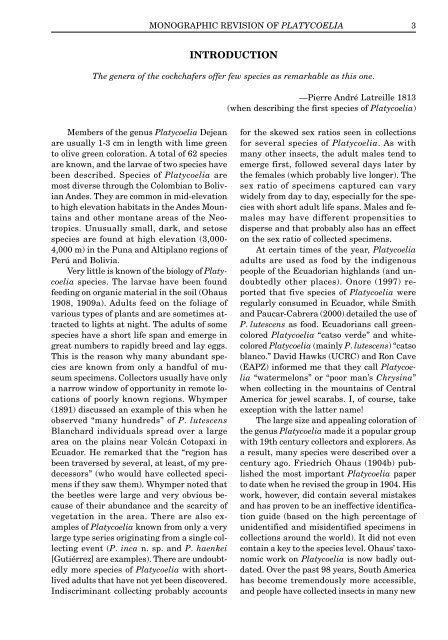Download full text (PDF 4.5 MB) - University of Nebraska State ...
Download full text (PDF 4.5 MB) - University of Nebraska State ...
Download full text (PDF 4.5 MB) - University of Nebraska State ...
Create successful ePaper yourself
Turn your PDF publications into a flip-book with our unique Google optimized e-Paper software.
Members <strong>of</strong> the genus Platycoelia Dejean<br />
are usually 1-3 cm in length with lime green<br />
to olive green coloration. A total <strong>of</strong> 62 species<br />
are known, and the larvae <strong>of</strong> two species have<br />
been described. Species <strong>of</strong> Platycoelia are<br />
most diverse through the Colombian to Bolivian<br />
Andes. They are common in mid-elevation<br />
to high elevation habitats in the Andes Mountains<br />
and other montane areas <strong>of</strong> the Neotropics.<br />
Unusually small, dark, and setose<br />
species are found at high elevation (3,000-<br />
4,000 m) in the Puna and Altiplano regions <strong>of</strong><br />
Perú and Bolivia.<br />
Very little is known <strong>of</strong> the biology <strong>of</strong> Platycoelia<br />
species. The larvae have been found<br />
feeding on organic material in the soil (Ohaus<br />
1908, 1909a). Adults feed on the foliage <strong>of</strong><br />
various types <strong>of</strong> plants and are sometimes attracted<br />
to lights at night. The adults <strong>of</strong> some<br />
species have a short life span and emerge in<br />
great numbers to rapidly breed and lay eggs.<br />
This is the reason why many abundant species<br />
are known from only a handful <strong>of</strong> museum<br />
specimens. Collectors usually have only<br />
a narrow window <strong>of</strong> opportunity in remote locations<br />
<strong>of</strong> poorly known regions. Whymper<br />
(1891) discussed an example <strong>of</strong> this when he<br />
observed “many hundreds” <strong>of</strong> P. lutescens<br />
Blanchard individuals spread over a large<br />
area on the plains near Volcán Cotopaxi in<br />
Ecuador. He remarked that the “region has<br />
been traversed by several, at least, <strong>of</strong> my predecessors”<br />
(who would have collected specimens<br />
if they saw them). Whymper noted that<br />
the beetles were large and very obvious because<br />
<strong>of</strong> their abundance and the scarcity <strong>of</strong><br />
vegetation in the area. There are also examples<br />
<strong>of</strong> Platycoelia known from only a very<br />
large type series originating from a single collecting<br />
event (P. inca n. sp. and P. haenkei<br />
[Gutiérrez] are examples). There are undoubtedly<br />
more species <strong>of</strong> Platycoelia with shortlived<br />
adults that have not yet been discovered.<br />
Indiscriminant collecting probably accounts<br />
MONOGRAPHIC REVISION OF PLATYCOELIA 3<br />
INTRODUCTION<br />
The genera <strong>of</strong> the cockchafers <strong>of</strong>fer few species as remarkable as this one.<br />
—Pierre André Latreille 1813<br />
(when describing the first species <strong>of</strong> Platycoelia)<br />
for the skewed sex ratios seen in collections<br />
for several species <strong>of</strong> Platycoelia. As with<br />
many other insects, the adult males tend to<br />
emerge first, followed several days later by<br />
the females (which probably live longer). The<br />
sex ratio <strong>of</strong> specimens captured can vary<br />
widely from day to day, especially for the species<br />
with short adult life spans. Males and females<br />
may have different propensities to<br />
disperse and that probably also has an effect<br />
on the sex ratio <strong>of</strong> collected specimens.<br />
At certain times <strong>of</strong> the year, Platycoelia<br />
adults are used as food by the indigenous<br />
people <strong>of</strong> the Ecuadorian highlands (and undoubtedly<br />
other places). Onore (1997) reported<br />
that five species <strong>of</strong> Platycoelia were<br />
regularly consumed in Ecuador, while Smith<br />
and Paucar-Cabrera (2000) detailed the use <strong>of</strong><br />
P. lutescens as food. Ecuadorians call greencolored<br />
Platycoelia “catso verde” and whitecolored<br />
Platycoelia (mainly P. lutescens) “catso<br />
blanco.” David Hawks (UCRC) and Ron Cave<br />
(EAPZ) informed me that they call Platycoelia<br />
“watermelons” or “poor man’s Chrysina”<br />
when collecting in the mountains <strong>of</strong> Central<br />
America for jewel scarabs. I, <strong>of</strong> course, take<br />
exception with the latter name!<br />
The large size and appealing coloration <strong>of</strong><br />
the genus Platycoelia made it a popular group<br />
with 19th century collectors and explorers. As<br />
a result, many species were described over a<br />
century ago. Friedrich Ohaus (1904b) published<br />
the most important Platycoelia paper<br />
to date when he revised the group in 1904. His<br />
work, however, did contain several mistakes<br />
and has proven to be an ineffective identification<br />
guide (based on the high percentage <strong>of</strong><br />
unidentified and misidentified specimens in<br />
collections around the world). It did not even<br />
contain a key to the species level. Ohaus’ taxonomic<br />
work on Platycoelia is now badly outdated.<br />
Over the past 98 years, South America<br />
has become tremendously more accessible,<br />
and people have collected insects in many new
















